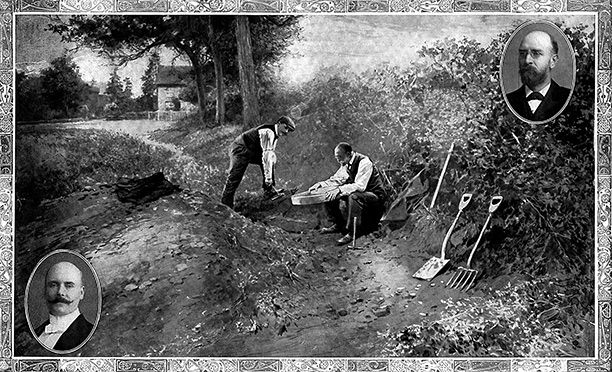Discovery of Piltdown Man announced
A great hoax was born on December 18th, 1912.
 Piltdown is an otherwise unremarkable hamlet in Sussex, east of Haywards Heath, which suddenly became famous for what seemed to be an astounding discovery. Allegedly, at some point before 1912 workmen in a gravel pit came across part of the skull of a hominid, or human-like creature, that seemed to be the much sought after ‘missing link’ between the apes and homo sapiens, or modern man. Not realising what it was, they broke it, but they gave the largest piece to a local lawyer and antiquary named Charles Dawson. He later found more fragments of the skull at the pit, or so he said when he took the finds to Arthur Smith Woodward, keeper of geology at the British Museum. Woodward joined Dawson for further explorations at Piltdown, where Dawson found more pieces of the skull and part of the jawbone. No bones of the rest of the body were ever found.
Piltdown is an otherwise unremarkable hamlet in Sussex, east of Haywards Heath, which suddenly became famous for what seemed to be an astounding discovery. Allegedly, at some point before 1912 workmen in a gravel pit came across part of the skull of a hominid, or human-like creature, that seemed to be the much sought after ‘missing link’ between the apes and homo sapiens, or modern man. Not realising what it was, they broke it, but they gave the largest piece to a local lawyer and antiquary named Charles Dawson. He later found more fragments of the skull at the pit, or so he said when he took the finds to Arthur Smith Woodward, keeper of geology at the British Museum. Woodward joined Dawson for further explorations at Piltdown, where Dawson found more pieces of the skull and part of the jawbone. No bones of the rest of the body were ever found.
By November 1912 the press was on the trail and Woodward announced the discovery to a meeting of the Geological Society in London the following month. It created a sensation and the creature was named Eoanthropus (‘dawn man’) dawsoni in Dawson’s honour, more commonly known as Piltdown Man. The remains were exactly what many leading British palaeontologists had been looking for, a creature combining ape-like and modern human characteristics. They accepted it with enthusiasm and consequently rejected far more significant discoveries made later on in Africa.
Some experts from early on had serious misgivings about Piltdown Man, but it was not until 1953 that an investigation at the Natural History Museum in London pronounced him ‘an elaborate and carefully prepared hoax’. Further investigations confirmed that the remains combined the cranium of a modern human with the jaw and teeth of an immature orangutan. They had been stained to make them look older and the teeth had been ground down with a file to make them seem more human. They had been deliberately introduced into the Piltdown gravels, which themselves were not remotely as old as had been claimed.
Charles Dawson had died in 1916. He was inevitably the principal suspect, but other candidates have included Sir Arthur Conan Doyle, who had a house near Piltdown and knew Dawson, the French Jesuit Pierre Teilhard de Chardin, who also knew Dawson and visited Piltdown with him, and Sir Arthur Keith of the Royal College of Surgeons, who has been accused of colluding with Dawson in what started off as a practical joke. Miles Russell, a Bournemouth University archaeologist, however, has discovered many cases of fakery by Dawson before the Piltdown discovery, which he has described as not a joke but the culmination of Dawson’s life’s work.




